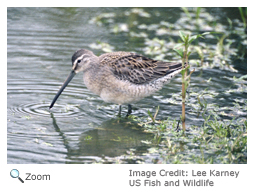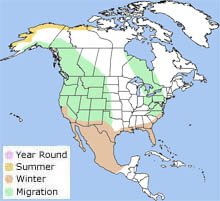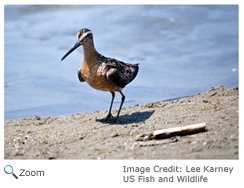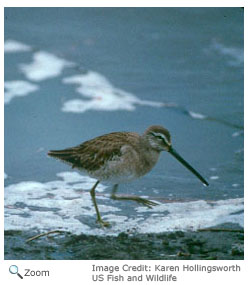Description
 The long-billed dowitcher is 11-12 inches in length. It has a long, straight black bill; long, green legs; a white lower back and rump; and white eyebrows. In the summer, adults have reddish underparts, bars on their breasts and sides, and reddish edges on the feathers on their uppersides. Winter dowitchers are gray. Males and females look alike, but females are slightly larger and have a longer bill. The long-billed dowitcher is 11-12 inches in length. It has a long, straight black bill; long, green legs; a white lower back and rump; and white eyebrows. In the summer, adults have reddish underparts, bars on their breasts and sides, and reddish edges on the feathers on their uppersides. Winter dowitchers are gray. Males and females look alike, but females are slightly larger and have a longer bill.
Range  The long-billed dowitcher breeds in western Alaska and northwestern Canada. It winters along the Atlantic and Pacific coasts from Washington and Virginia south to Mexico. The long-billed dowitcher breeds in western Alaska and northwestern Canada. It winters along the Atlantic and Pacific coasts from Washington and Virginia south to Mexico.
Habitat  During breeding season, the long-billed dowitcher lives on the tundra. During migration and in the winter, the long-billed dowitcher is found on mudflats, marshes, and at the edge of freshwater ponds and marshes. During breeding season, the long-billed dowitcher lives on the tundra. During migration and in the winter, the long-billed dowitcher is found on mudflats, marshes, and at the edge of freshwater ponds and marshes. |
|
Diet  The long-billed dowitcher uses its long bill to poke in the mud and find food. The long-billed dowitcher looks like a sewing machine as its long bill probes up and down in the mud! Its diet includes insect larvae, earthworms, crustaceans, moss, plant parts, seeds, and snails. The long-billed dowitcher uses its long bill to poke in the mud and find food. The long-billed dowitcher looks like a sewing machine as its long bill probes up and down in the mud! Its diet includes insect larvae, earthworms, crustaceans, moss, plant parts, seeds, and snails.
Life CycleThe female long-billed dowitcher lays four eggs in a grass or leaf-lined nest on the ground. Both the male and female incubate the eggs. The female starts incubating the eggs while the male chases off intruders. Later, the male takes over and incubates the eggs up until the time they hatch three weeks after being laid. He then takes care of the chicks until they fledge.
BehaviorThe long-billed dowitcher is very aggressive in defending its territory.
|


 The long-billed dowitcher breeds in western Alaska and northwestern Canada. It winters along the Atlantic and Pacific coasts from Washington and Virginia south to Mexico.
The long-billed dowitcher breeds in western Alaska and northwestern Canada. It winters along the Atlantic and Pacific coasts from Washington and Virginia south to Mexico. 
